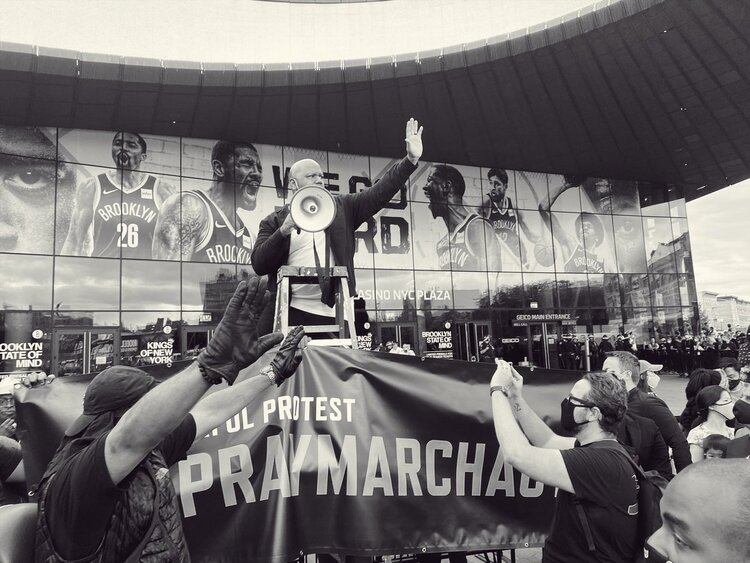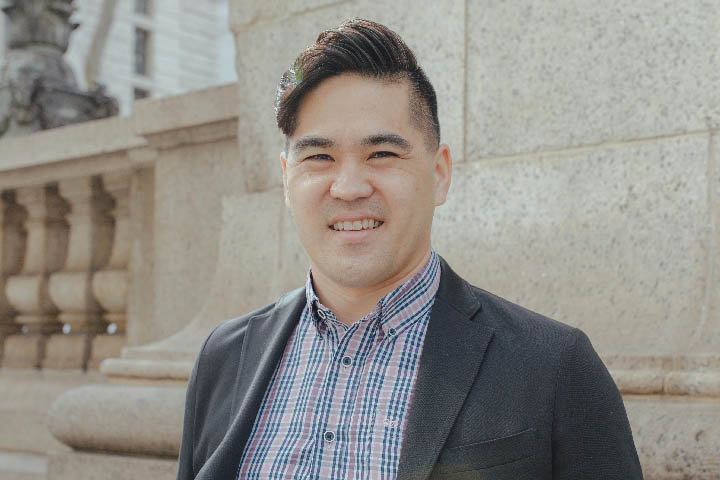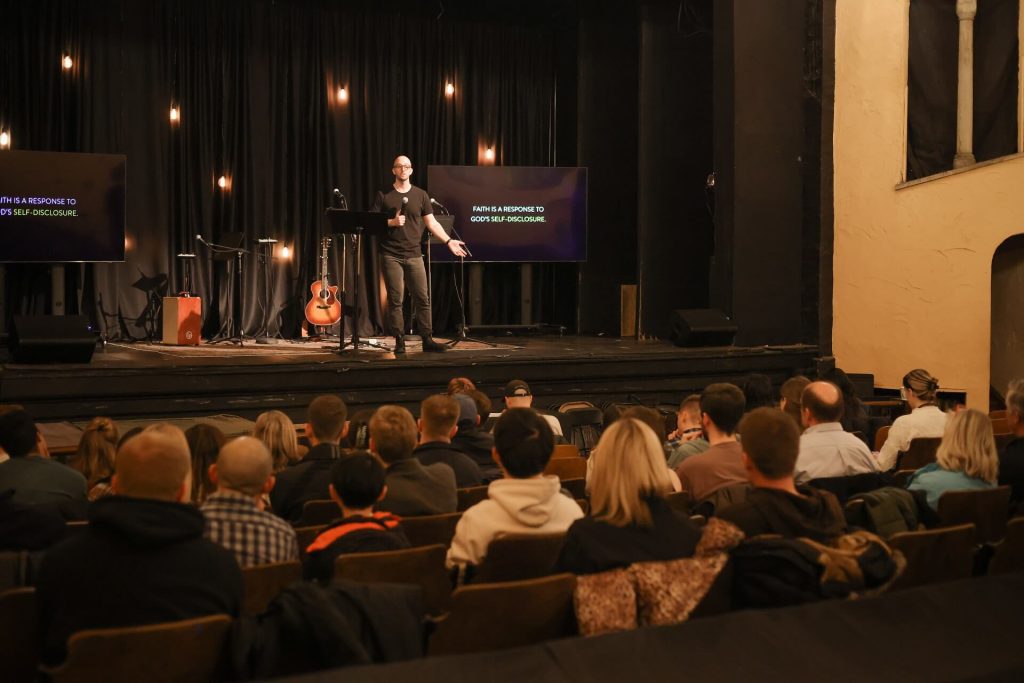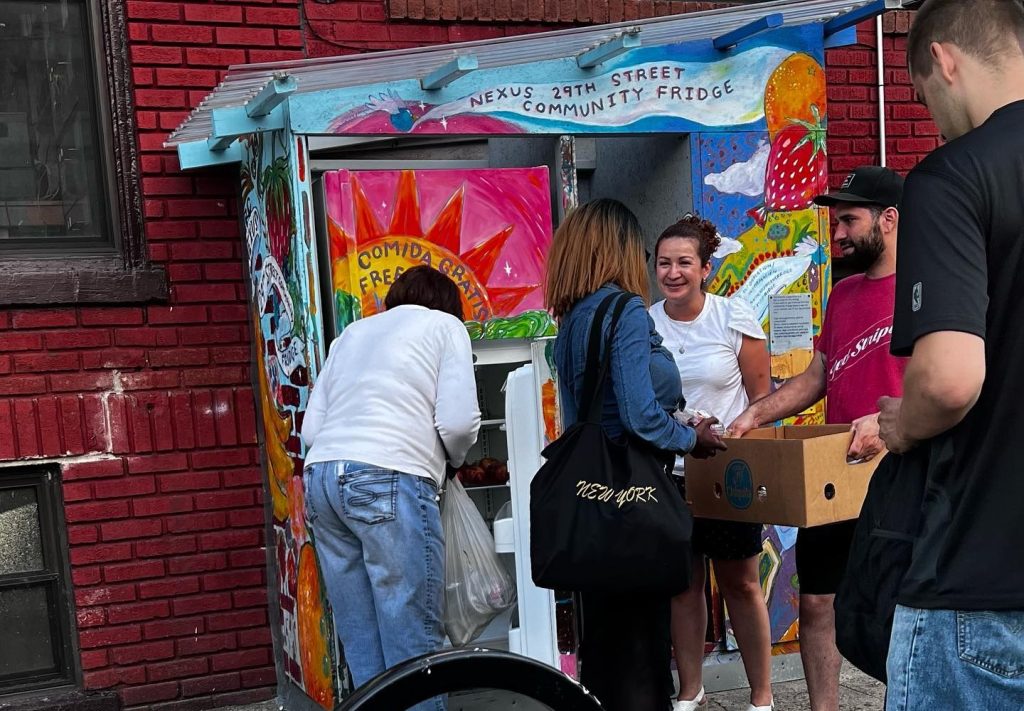I haven’t been this proud to be a part of the church in 15 years.
That’s what I thought to myself as I walked down Kingsbridge Avenue in the Bronx as part of a prayerful protest called Pray March Act. Prompted by the most recent violence against black bodies, a group of churches organized a protest in Brooklyn. I marched with them. Then they had another one in the Bronx. I went to that one, too.
I believe in the church. But there are a lot of things that my church does and says in this country that are cruel and embarrassing. As a Christian, I am troubled by it. As a pastor and church planter, I always wonder if I de facto represent that cruelty to others. I often have to force myself to imagine the glory of the church described in the Bible in spite of what I see. It’s a prayer of hard faith. But for an hour or so walking down Kingsbridge Avenue, I found that I could walk both by faith and by sight. I noticed that I was walking taller in my public Christian skin than usual.
This is what happens when you’re marching in a sea of improbably diverse Christians from all over New York City, disruptively taking a South Bronx street shouting chants in unison of “We are the church and we want justice,” and then spontaneously breaking out into songs of praise to our Savior. When Rev. Pura Coniglio prayed for us at the beginning of the march, I thought, “Whoa. This woman knows that Jesus saved her.” When I saw the line of pastors in their clerical collars moving down the street like a locomotive I thought, “Whoa, that looks like justice coming.” It was the best of a worship service and the best of a civil rights movement.
There has been a lot of debate over whether protests actually bring about change. These recent marches and rallies seem different—once-in-a-generation different. They have served as a short-term accelerant to new legislation for police accountability and new attitudes, but also to new conflict, too. As a protester, I for one sensed that we were actively changing the world in Jesus’ name. We proclaimed his grace, and we worked for his justice.
There were a million things to notice during these marches, but here are five especially worth mentioning.
1. THEY WERE MINORITY-LED AND OPEN-HANDED.
It was clear that the protest was led by black- and brown-skinned pastors. No surprise—the protests were born out of the silence of the privileged. Minorities would be the ones to speak out and address white supremacy. That is a lesson in itself, and it was an honor to be led by them.
One of the blessings of this leadership was that, as a participant, I couldn’t have told you which one individual was in charge. Leadership was shared. Directions were so clear, leadership was so biblical and competent, that wherever we were led, the whole church followed—privileged included. But beyond that, it was remarkable that the power dynamics of leadership were managed in a way that democratized the group, leaving Christ honored above all.
Did suffering teach them to detect power imbalance better than the rest of us? How did they learn to lead like this?
2. THEY WERE LOCALLY-LED AND CONTEXTUALIZED.
This was a march led by the churches of the Bronx for the people of the Bronx, even though the whole city was invited. Signs of these churches’ presence were embedded in the neighborhood everywhere. Pastors and marchers constantly stepped out of the march to greet someone they knew from the area on the sidewalk. The local police precinct greeted the pastors before the march like old friends, vowing that they were there to protect us, not threaten us. Clearly this was because they all worked together for the good of the neighborhood.
Prophetic speeches were not only aimed at systemic racism and dominant culture’s silence, but at prejudice toward Afro-Latino communities as well. Bold moments of prophecy take tons of street cred and deep knowledge of the neighbors in the community. Racism is racism and needs to be called out, but the march leaders knew how to do it in their backyard.
Am I loving my neighbor like that? How do I need to order my life to develop these relationships?
3. THEY ACKNOWLEDGED A LONG PAIN.
The whole world would not have enough room to record all the hardships that black folks have had to endure. The protest speeches were a witness to that—prioritizing naming the murdered, honoring their lives in chants, and making those names a rallying cry. All of this draws out lament and rebellion at the same time. The force behind this came not only due to the sheer amount of names that were recognized, but the scale of evil that they endured.
It means something to publicly say that God is against that evil. Every side-eye suspicion, every silent inaction, every murder will be answered for one day.
Is this a comfort to the afflicted? Did Jesus die so I could take shelter in his grace for even my complicity?
4. THEY WERE A TRANSFORMATIONAL DISCIPLING EXPERIENCE.
As a pastor, I’m always looking for ways to disciple and grow individuals in unity and justice. Brenda Salter McNeil says that the beginning of a change toward unity and justice is often kick-started by what she calls a “catalytic event,” a fight, an argument, a death that means you can’t ignore injustice anymore. The problem with relying on events like these is that you can’t really introduce race conflict just to make disciples. For some in my church, the recent deaths of Ahmaud Arbery and George Floyd were just the latest in a 400-year story of pain; for others, they were catalytic events—they began to wake.
Evens the protests themselves proved catalytic. One of our members had listened to the stories of pain and outrage from our black members. He attempted to go to a vigil in our neighborhood but got spooked for some reason and left early with a sense of fear. After a night of deep processing conversations about why he felt afraid, he felt convicted that he wouldn’t risk his safety to improve the lives of his friends. And out of repentance and conviction, he went out to protest the next day. He hasn’t missed one since. Is his singular response the whole of change needed? No. But it moved the needle. The protests at least forced the question: Will I stand with my brothers and sisters who are hurting, or not? What is God calling me to sacrifice in order to become partners in their pain?
5. THEY WERE DRIVEN BY MILLENIALS.
The last observation is that the march was full of millennial energy, technology, and leadership. The street was full of young adults. Granted, many of the old Bronx guard could not come out due to COVID-19 concerns; otherwise, they would have been out front leading the charge as they had been for decades. But I also wondered how they’d respond to the fact that you could get a participant’s guide to the march by texting O-U-T-L-I-N-E to a number, and it would magically appear on your phone. The way you knew the route of the march and the context of the chants was probably through Instagram or Facebook. The protest was live-streamed with a Zoom prayer room, and people could participate at home if they were sick.
I heard that it was originally thought there would be 300 people attending the Brooklyn Prayerful Protest. They had more than 2,000 show up. Social media did that. Mobility without kids did that. Relationships fashioned in democratic ways did that. Pragmatic decision-making did that. Millennials did that. We need seasoned leaders like James Roberson and Michael Carrion, but I also thank God for leaders like Justin Mattera, Sydney Wright, Rasool Berry, Ramny Perez, Tim Holmes, and dozens of other young leaders who stood up and led us. They will be leading us for years to come.
Will we let Jesus lead in them?
For more reflection on the church’s role in protests, listen to Reyn on the Building Beloved Community podcast below:



